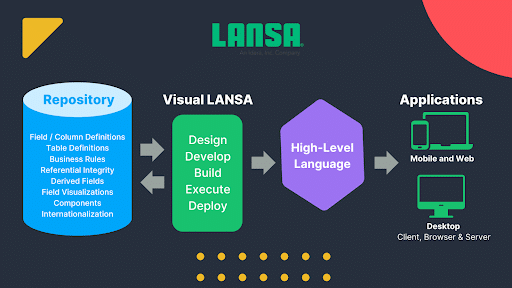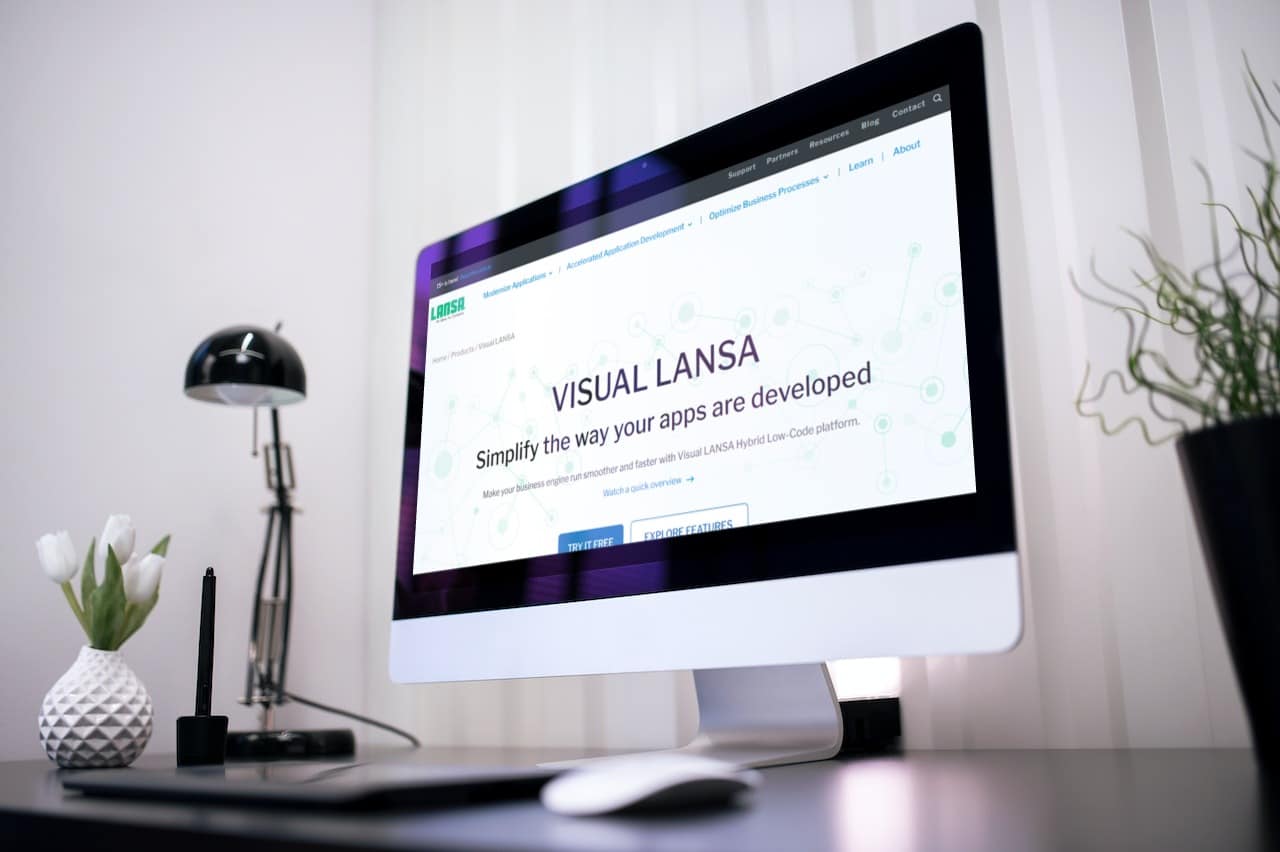Developers are under constant pressure to create and maintain high-performance applications. In their quest to build and innovate rapidly, inefficiencies are, ironically, often overlooked. One familiar example is code redundancy, which occurs when the same code is rewritten across multiple projects. This practice not only wastes precious development time but also increases the risk of errors and inconsistencies, ultimately undermining overall code quality.
This is where Visual LANSA’s Repository comes in. It provides a centralized database for managing and reusing application components and resources. This empowers software developers to streamline cross-platform development, eliminate code redundancy, and reduce development time significantly. By leveraging Visual LANSA Repository, you can create applications that are faster to develop, more efficient, and easier to maintain, which will enhance your overall coding experience and ensure scalability.
Key Insights
- Visual LANSA’s Repository is a database that stores fields, tables, relationships, components, and systems variables and retrieves information about applications from the central location.
- The Visual LANSA Repository ensures consistency, reduces code redundancy, and enhances collaboration among development teams.
- Reusing stored components significantly cuts down the development time while maintaining high-quality, error-free code.
- Updates made within the Repository propagate universally across applications, enabling seamless cross-platform deployment and reducing code redundancy.
What is Visual LANSA’s Repository?
Visual LANSA’s Repository is a centralized database that stores all application logic and components, including fields, tables, relationships, and system variables. It supports rapid application development by allowing developers to reuse high-quality code and maintain consistent design across projects.
This centralized Repository simplifies code management, fosters collaboration, and supports scalable updates across multiple applications. It also enhances code maintainability by reducing redundancy and ensuring efficient, error-free development.
Visual LANSA’s Repository Workflow
Repository Benefits
Visual LANSA Repository serves as a single source of truth for managing application information and streamlining development by enabling developers to reuse code and access shared resources from one central location. Furthermore, it offers various benefits for application developers:
Centralized asset management for better collaboration
One major benefit of Visual LANSA’s Repository is that it serves as a centralized hub where all application components, assets, business logic, and resources are defined, stored, and cross-referenced. In addition, this centralization facilitates collaboration among developers by offering them a single source of truth for managing assets between the hosts and the client. It reduces errors caused by inconsistent coding practices and ensures a more streamlined approach across teams.
Simplified updates for universal and cross-platform deployment
When simplifying and updating the application universally or making updates for cross-platform deployment, Visual LANSA’s Repository helps you to conduct these changes once and propagate those changes universally. This ultimately helps developers avoid writing codes multiple times and reduces the risk of error.
Reduced development time through reusable code and assets
Developers can significantly reduce development time by reusing the codes and assets stored in the Repository. For example, assume your team has designed a function to validate a user input (e.g. detecting invalid characters or enforcing length constraints). You can store it inside the Repository for use in other applications or modules and avoid implementing it from scratch in every application or module. This way, you save time and effort while reducing the possibility of introducing new bugs. Developers can focus on more complex tasks to shorten the overall development cycle and maintain high-quality and error-free code.
Lower maintenance costs through advanced cross-referencing
When a component requires modification, developers can use the Repository’s cross-referencing capabilities to identify where the component is being used. It also generates and stores detailed impact lists for precise and efficient updates, avoiding errors and rework. By optimizing the change assessment and implementation process, Visual LANSA reduces overall application maintenance costs by up to 80%.
Improved control over application versioning and deployment
Visual LANSA’s Repository improves control over application versioning and deployment by integrating with Git. This integration allows software developers to track changes, manage repositories, and collaborate directly within the environment. Git integration also enhances workflows, reduces errors, and ensures code integrity throughout development. Its version control features, like branching, merging, and commit history, improve collaboration and maintain code consistency. In addition, it provides improved oversight of application versioning and deployment since all components are centrally managed.
Building Your Application with Visual LANSA’s Repository
With Visual LANSA’s Repository, you can speed up the application development process while maintaining high-quality code and minimizing errors. Utilizing its centralized nature for managing and reusing application components makes creating applications more efficient.
Step 1: Plan your Repository structure
- When developing your application, it is ideal to define the fields, tables, business rules, and other reusable components in your Repository.
- Fields: They store data elements like CustomerID and OrderDate, which ensures consistency across the platform.
- Tables: Used to organize related data into logical structures, such as a Customer table with fields for Name, Email, and Phone.
- Business rules: These are centralized rules like data validation or formatting to enforce consistent behavior across your application.
- Reusable components: These are common application parts like buttons, input fields, or entire modules that can be reused to save time and maintain design standards.
Example: An example of a reusable field could be CurrencyCode, whereby all the monetary values for various applications or modules could be standardized. It lets the usage of consistent currency codes such as “USD,” “EUR,” and “JPY” to avoid any confusion or errors raised because of mixed formats. In the end, it will let the teams do easy tracking of the financial data without any mistaken calculations, and clear auditing trails in projects where many different currencies would be involved.
Developers can also inform LANSA about external databases, which populate the data dictionary with fields and definitions.
Step 2: Add Metadata
Metadata offers additional information and context about the fields, tables, and components within your application. Adding metadata ensures better organization, discoverability, and usability across projects.
- Validation Rules: Define rules to ensure data integrity by enforcing specific formats, ranges, or constraints on input values.
- Referential Integrity: Establish relationships between tables, such as primary and foreign keys, to maintain consistency and prevent orphaned data.
- Virtual Field: By specifying a virtual field, you can derive values from the real field defined in the IBM i file definition.
Example: Adding metadata to a customer email field can define constraints such as only accepting valid email addresses and enforcing a maximum character length. By applying these rules, you help ensure accurate and consistent data entry across your system.
Step 3: Develop Your Application
Apart from adding the metadata, you can store application logic in the Repository so that it can be easily accessed across projects. This allows applications to be developed smoothly and effectively, ultimately increasing their performance.
- Server modules: Server modules perform backend jobs like retrieving a set of records from a database or consuming REST APIs. It helps with centralized logic to ensure that the impact of changes is immediately updated in all projects without redundancies and errors.
- It allows software developers to retrieve records from a local or remote database to simplify the codes and avoid code redundancy.
- With the help of Visual LANSA’s Repository, you can publish and consume REST APIs, which improve application performance.
- Developers can access other data sources like Excel spreadsheets or NoSQL databases.
- Routines for common operations:
- During the application development process, calculating employee tenure provides data for performance analysis.
- When building applications, accessing email clients and FTP servers helps you build robust applications.
- Developers can use authentication standards like OAuth2 to streamline maintenance and application coding.
Step 4: Versioning
Versioning is a crucial process when developing or deploying an application, and it ensures that the changes are tracked and managed effectively. This step helps you to maintain a history of updates, revert to previous versions if necessary, and ensure consistent application functionality across all stages of development.
- Version Control Systems: Use tools to track changes made to Repository items, documenting modifications for better traceability.
Step 5: Deployment
Deployment involves delivering the completed application to end-users or production environments. The Repository simplifies the deployment process with efficient tools for packaging, updating, and maintaining your application.
- Deployment Tools: Visual LANSA’s built-in tools are used to package applications and push updates to production environments. These tools help ensure that all users have access to the latest features and updates.
Improve your development skills by mastering the Repository — enroll in this comprehensive Visual LANSA Repository course.
Accelerate Development with Visual LANSA’s Repository
Building applications quickly without compromising quality is crucial for business success. However, maintaining speed while incorporating new features remains a challenge for developers. Visual LANSA’s Repository offers a powerful solution for IBM i developers by streamlining the application development process. It helps to store, manage, and retrieve the application codes efficiently as well as reduces code redundancy, and accelerates development. By centralizing assets and promoting reusability, the Visual LANSA Repository helps developers increase productivity, improve code quality, and ensure scalability.
Boost Efficiency with a Centralized Codebase
Writing the same code again and again is slowing down your development process. Discover how creating a Repository on Visual LANSA, a professional low-code platform for IBM i developers, can accelerate your application development, eliminate code redundancy and boost efficiency. Talk to us to learn more and start your development experience today!











